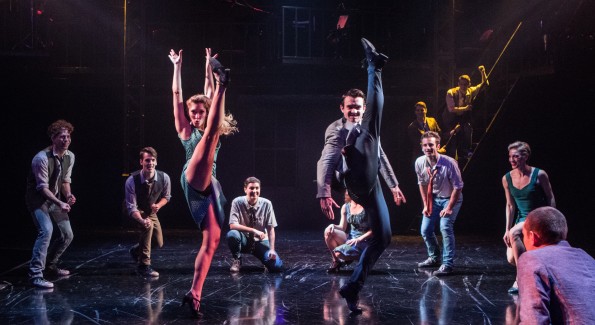Signature Theatre expertly tackles a physically demanding musical in ‘West Side Story.’

Jennifer Cordiner (Graziella) and Max Clayton (Riff) in “West Side Story” at Signature Theatre. (Photo by Christopher Mueller)
Signature Theatre did not cut any corners in its lavish, full-throated production of “West Side Story”and it shows. Seeing it is an exciting, fulfilling experience. There is a full cast of 30 with a 16-member orchestra and it all works in Signature’s intimate Max theater space.
“West Side Story” is an American theater legend that brought together some of the brightest stars of Broadway: directed and choreographed by Jerome Robbins, book by Arthur Laurents, music by Leonard Bernstein and lyrics by Stephen Sondheim, in his Broadway musical debut. It opened on Broadway in 1957 after a tryout in Washington and went on to be nominated for six Tony Awards. It also became a hit movie in 1961 that was nominated for 11 Academy Awards, winning 10, including Best Picture.
That kind of success creates complicated, hard to match, expectations for Signature’s director, Matthew Gardiner, in controlling his rival street gangs – the Jets and the Sharks – in a musical that depends on actors who have to also be able to sing and dance. And Gardiner surpasses other “West Side Story” productions, as well as his other brilliant directing successes such as “Sunday in the Park with George” and “Cabaret.”
Signature’s Max Theatre stage has been expanded and configured with the audience on three sides. The unusually large cast on stage for energetic dance numbers requires that the performance space takes up a considerable portion of the theater and the dance sequences take up every bit of the space. There is also the unusually large orchestra under the direction of the Signature’s versatile Jon Kalbfleisch above the fourth end of the stage that enhances Bernstein’s memorable score. It is a tribute to Parker Esse’s choreography that the dancing is so disciplined, fluid and dramatic. And no member of the audience, according to Signature’s press release, is “more than 20 feet from the stage” to enhance the experience.
Misha Kachman’s scenic design includes a metal framework above and around the room that represents the tenement fire escapes, or balcony, where so much of the action revolves. “West Side Story” is, after all, a takeoff on Shakespeare’s “Romeo and Juliet,” and where would that play be without a balcony?
“West Side Story” relates the volatile relationship between the white street toughs, the Jets, unable to adjust to the immigration flow into their neighborhood turf of a Puerto Rican gang, the Sharks. Into this tense caldron of mutual distrust and anger, Tony (Austin Colby), a former Jet moving away from the gang lifestyle, sees Maria (Mary Joanna Grisso), who has recently come to New York from Puerto Rico, at a dance designed to hopefully find a peaceful way for the two gangs to get to know and understand each other. It is a fatal attraction of love at first sight that can never be on this neighborhood battleground.
Colby dominates the stage with his dreamy, expectant “Something’s Coming” and then shortly later in “Maria,” expressing his love for her delicate beauty. He has a magnificent presence and voice. He looks, however, more like a prep school boy than a street tough, but that can be said of most of the gang members, but this is a musical out of the 1950s, and the cast represents a different era and look for street gangs.
Grisso is a believable Maria caught up in the throes of young, first love, the kind of love that isn’t rational, but is euphoric. She and Tony believe naively that they can escape the turf wars and find a new life, somewhere. Grisso, is a fragile beauty with a voice that has a heartbreaking effect and finds no argument when she sings the happy “I Feel Pretty,” backed up by Consuelo (Olivia Ashley Reed), Rosalia (Kate Mariko Murray) and Francisca (Lida Mason).
Tony and Maria’s duet for the “Balcony Scene,” with Maria on the fire escape and Tony on the ground expresses the rapidly growing love that ignores the impossibility of who they are and the forces that are aligned against them. Maria, unfortunately, is the sister of Bernardo (Sean Ewing) the angry, unforgiving leader of the Sharks. And a rumble is brewing between the two gangs.
Maria has a reluctant ally in Anita (Natascia Diaz) who is also Bernardo’s girlfriend. Diaz has exquisite dance movements and controls one of the best roles in “West Side Story” and is in great voice when she sings the amusing, “America”, also backed by Reed, Murray and Mason, with the addition of Jasmine Alexis as Teresita.
Later Anita sings the warning to Maria “A Boy Like That”, to which Maria responds with, “I Have a Love.” It is a painful, heart-rending recognition of a love that cannot be and the two girls understand each other.
I would be remiss if I neglected to recognize the Jets “Gee, Officer Krupka”, a happy taunting song of the pesky police. And the ever versatile talents of Bobby Smith in the non-singing or dancing role of Doc, who runs the soda fountain hangout that is neutral territory, and as Glad Hand, an ineffective do-gooder who tries to establish peace between the gangs.
“West Side Story” is a production that more than lives up to the demanding standards of Signature Theatre, a place where the American musical is staged with an artistry and sensitivity that is hard to match anywhere. There is a genuine complexity and risk in staging a Broadway classic like “West Side Story.” Gardiner and Esse have, however, put together a truly talented cast that easily handles “West Side Story’s” complex demands of performers who are equally comfortable with the unforgivable demands of acting, singing and dancing.
“West Side Story” continues through January 31 at Signature Theatre, 4200 Campbell Ave., Arlington, Va. Tickets are currently sold out.
